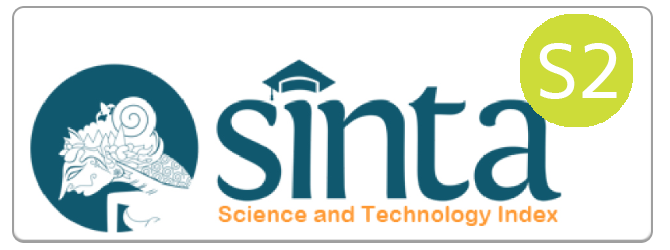PENGARUH UMUR, GENDER, DAN PENDIDIKAN TERHADAP PERILAKU RISIKO AUDITOR DALAM KONTEKS AUDIT ATAS LAPORAN KEUANGAN
Downloads
ABSTRACT
This research aims to examines and proves the influence of auditor's risk behavior generated by age, gender, and education. This is important because risk is the main focus on Professional Standard on Auditing (PSA) as auditor guidance to audit of financial statement, so it is important to examine that auditor perception and propensity to face that risk.
This study is a quantitative approach, which respondents are auditors involved in the audit of financial statements in Indonesian. The data was collected using a questionnaire Ionescu & Turlea (2011). This research using age (X1), gender (X2), and education (X3) as independent variable and auditor's risk behavior (Y) as dependent variable. Hypothesis testing was performed using multiple linear regression with a 5% significance level. The result show age has a positive and significant influence on auditor's risk behavior, in a financial audit context, while gender and education has not significant influence on auditor's risk behavior.
Amaefula, C., Okezie, C. A., & Mejeha, R. (2012). Risk Attitude and Insurance : A Causal Analysis.
American Journal of Economics, 2 (3), 26-32. doi: 10.5923/j.economics.20120203.01 Barber, B., & Odean, T. (2001). Boys Will Be Boys : Gender, Overconvidence, and Common Stock
Investment. Journal of Economic, 261-292.
Bellante, D., & Green, A. C. (2004). Relative Risk Aversion the Elderly. Review of Financial Economics, 13, 269-281.
Chauffman, E., Shulman, E. P., Steinberg, L., Claus, E., Banich, M. T., Graham, S., & Woolard, J. (2010). Age Differences in Affective Decision Making as Indexed by Performance on the Iowa Gambling Task. Developmental Psychology, 46 (1), 193-207. doi: 10.1037/a0016128
Chang, C.-C., Devaney, S. A., & Chiremba, S. T. (2004). Determinants of Subjective and Objective Risk Tolerance. Journal of Personal Finance, 3 (3), 53-67.
Dror, I. E., Katona, M., & Mungur, K. (1998). Age Differences in Decision Making : To Take Risk or Not? Gerontology, 44, 67-71.
Duasa, J., & Yusof, S. A. (2013). Determinants of Risk Tolerance on Financial Asset Ownership : A Case of Malaysia. International Journal of Business and Society, 14 (1), 1-16.
Elder, R. J., Mark, B. S., & Alvin, A. A. (2008). Auditing and Assurance Services An Integrated Approach (12 ed.). New Jersey: Pearson Education.
Faff, R., Mulino, D., & Chai, D. (2008). On The Linkage Between Financial Risk Tolerance and Risk Aversion. The Journal of Financial Research, XXXI (1), 1-23.
Festinger, Leon. (1962). Cognitive Dissonance. Scientific American Offprints,Vol 200. No.4 pp 93- 102.
Gardner, M., & Steinberg, L. (2005). Peer Influence in Risk Taking, Risk Preference, and Risky Decision Making in Adolescence and Adulthood : An Experimental Study. Developmental Psychology, 41 (4), 625-635. doi: 10.1037/0012-1649.41.4.625
Grable, J. E., McGill, S., & Britt, S. (2009). Risk Tolerance Estimation Bias : The Age Effect. Journal of Business & Economics Research, 7 (7).
Http://www.google.com/url?sa=t&rct=j&q=&esrc=s&source=web&cd=3&cad=rja&ved=0CEgQFjA C&url=http%3A%2F%2Fwww.ppajp.depkeu.go.id%2Fremository%2Fdownloads%2FProfil
%2520AP%2520dan%2520KAP.pdf&ei=WoKFUpHrCo- lkgWQsoG4AQ&usg=AFQjCNFeXnBfcCdT15qVM06v23mp5lpp1Q&sig2=b4jLmKitQtmnt gS6Y7XUJw&bvm=bv.56643336,d.dGI. Diakses 9 Februari 2013.
Indonesia., I. A. P. (2013). Standar Profesional Akuntan Publik Tujuan Keseluruhan Auditor Independen dan Pelaksanaan Audit Berdasarkan Standar Audit. Jakarta: Salemba Empat.
Ionescu, I. O., & Turlea, E. (2011). The Financial Auditor's Risk Behaviour-The Influence of Age on Risk Behaviour in A Financial Audit Context. Accounting and Management Information Systems, 10 (4), 444-458.
Jayathilake, P. M. B. (2013). Gender Effects on Risk Perception and Risk Behavior of Entrepreneurs at SMES in Sri Lanka. Asia Pasific Journal of Marketing & Management Review, 2 (2).
Johnnie, P. (1993). Formal Education : A Paradigm of Human Resource Development. The International Journal of Educational Management, 7 (5), 4-8.
Riley, W. B., & Chow, K. V. (1992). Asset Allocation and Individual Risk Aversion. Financial Analysts Journal, 48 (6), 32-37.
Rolison, J. J., Hanoch, Y., & Wood, S. (2012). Risky Decision Making in Younger and Older Adults : The Role of Learning. Psychology and Aging, 27 (1), 129-140. doi: 10.10137/a0024689
Santrock, J. W. (2004). Educational Psychology (2 ed.). New York: McGraw-Hill Companies, Inc. Santrock, J. W. (2011). Life Span Development (13 ed.). New York: McGraw-Hill Companies, Inc. Sitkin, S. B., & Pablo, A. L. (1992). Reconceptualizing The Determinants of Risk Behavior.
Academic of Management Review, 17 (1), 9-38.
Wang, H., & Hanna, S. (1997). Does Risk Tolerance Decrease With Age? Financial Counseling and Planning, 8 (2).
Wendy. (2010). Apakah Investor Saham Menderita Myopic Loss Aversion? Eksperimen Laboratori.
Jurnal Bisnis dan Ekonomi (JBE), 17 (2), 85-96.
Yao, R., Sharpe, D. L., & Wang, F. (2011). Decomposing the Age Effect on Risk Tolerance. The Journal of Socio-Economics, 40, 879-887. doi: 10.1016/j.soec.2011.08.023
The journal allows the author to hold the copyright of the article without restrictions.
The journal allows the author(s) to retain publishing rights without restrictions
The legal formal aspect of journal publication accessibility refers to Creative Commons Attribution Share-Alike (CC BY-SA).
Jurnal Ekonomi dan Bisnis Airlangga (JEBA) is licensed under a Creative Commons Attribution-ShareAlike 4.0 International License

















